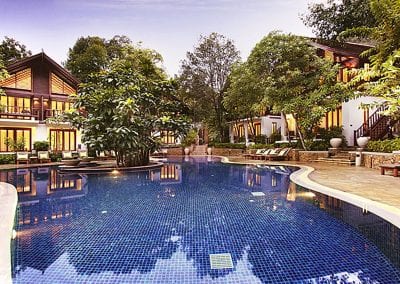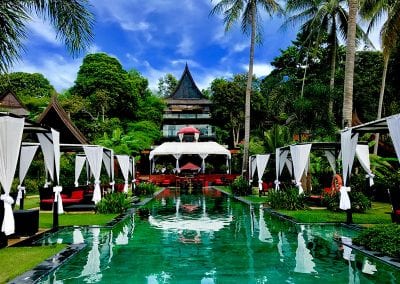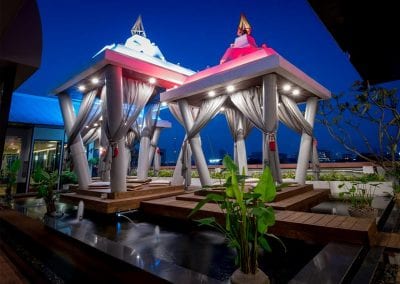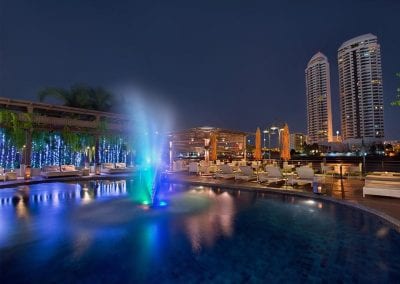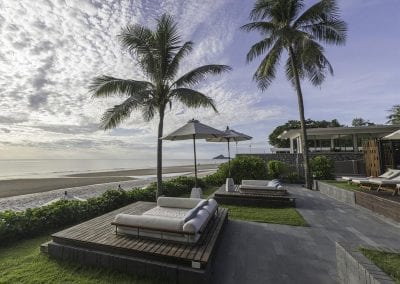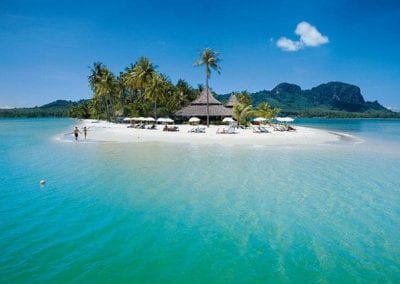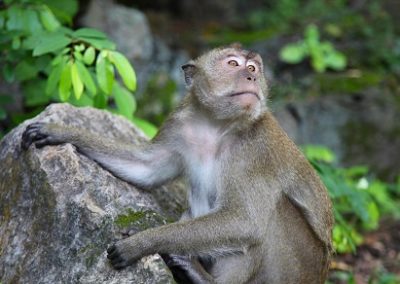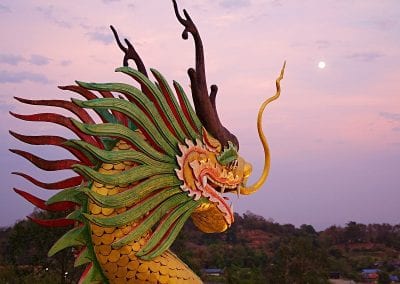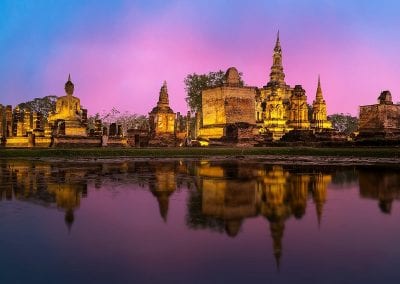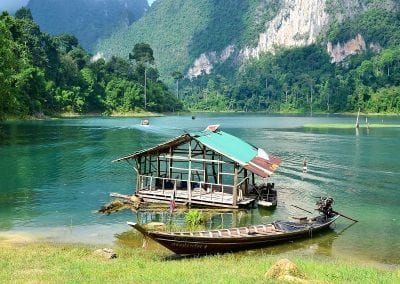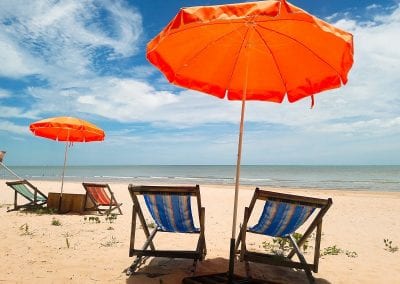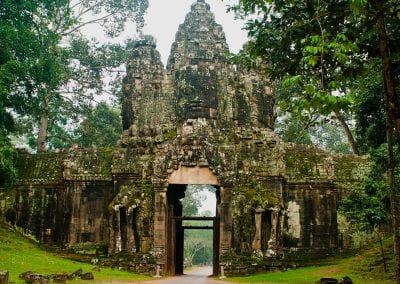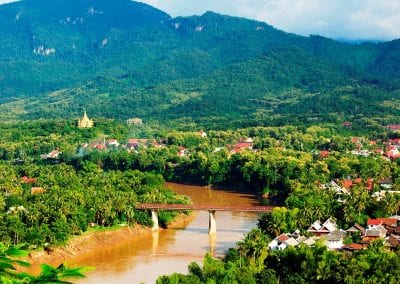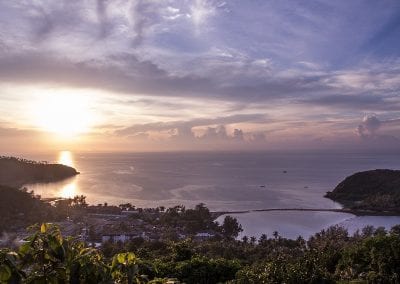JANUARY
With moderate conditions throughout the country, January is a great month for a visit to Thailand. With temperatures typically around 20-24°C, and a welcome breeze, conditions are ideal for a cycle tour in the Chiang Mai countryside or trekking in the hills of Chiang Rai. The far north can get a little colder, so it’s advisable to pack warm clothing if you visit this region. Due to their lower altitude, Bangkok and Pattaya are a little warmer.
The beaches to the south enjoy average temperatures around 26-29°C. You may still experience some short sharp showers. Diving conditions on the west coast around Krabi and Phuket are excellent. s average around 26°C.
FEBRUARY
In February, the north of Thailand, Chiang Mai and Chiang Rai, is mostly dry and cool, with little to no rain. Temperatures average around 22-25°C. This is perfect weather for the outdoor activities the north is famous for. Further south in Bangkok and Pattaya things are a little warmer due to the lower altitude, with temperatures hovering around the high 20s°C.
To the south, expect plenty of blue skies and sunshine. Temperatures are a little higher here, maybe averaging around 26-31°C. Diving conditions are excellent on the west coast, around Phuket, Krabi and Koh Samui, with warm temperatures and clear visibility.
MARCH
March sees the beginning of higher temperatures in Thailand. This is felt in Chiang Mai to the north, where the cooler winter months give way to daytime temperatures of up to 35°C. Bangkok and Central Thailand are even warmer, so it may be best to plan for shorter excursions in this region, rather than full-day adventures.
To the south, conditions are hot, sunny and dry, with the mercury hovering around the 26-31°C mark. The west coast beaches of Krabi and Phuket are a little warmer than Koh Samui and the beaches on the east coast. Diving conditions on the west coast are ideal – you may spot some whale sharks and manta rays in March.
In March and April, farmers practice ‘slash and burn’ farming in the north and north east. Ground is cleared in February, and, once dry, unneeded brush and wood is burnt. This may cause haze at times, especially in the countryside.
APRIL
There is only one word to characterise temperatures in Thailand in April: hot! You can expect the mercury to hit the high 30s°C. The heat in Bangkok and Pattaya in Central Thailand can be especially oppressive, so plan for shorter trips rather than all-day excursions.
Things are a bit cooler in the south, averaging around 29-34°C. In April, the east coast beaches are preferable to the west coast, where rain showers can be expected, especially towards the end of the month. The east coast is also better for diving than the west coast in April. Koh Samui has excellent underwater visibility.
You may experience some haze in Thailand at this time of year – this is due to the ‘slash and burn’ farming practiced by farmers, particularly in the north and north east. New land is cleared in February, and, once it is dry, unwanted brush and wood is burnt off. This shouldn’t be a problem in the south, but you may see some haze around Chiang Mai and Chiang Rai in the north.
MAY
Throughout the country, the temperature drops in May, giving some welcome respite from the extreme heat of the previous months. However, you may encounter highs up to 33-34°C. As we edge towards the rainy season, intermittent showers are to be expected.
Humidity remains high, and there is a good chance of rain on the west coast beaches of Phuket, Khao Lak and Krabi. If you want a guarantee of sunshine, head for Koh Samui off the east coast, or Hua Hin, where very little rain can be expected.
May is a great month for a visit to Thailand. There is plenty of sunshine and not too much rain, and far fewer visitors come than in the preceding months.
JUNE
Temperatures in Thailand remain high in June, hovering around 29-31°C. Rainfall will probably be encountered throughout the country, though at first it will probably be short sharp showers, with plenty of sunshine for the rest of the day.
Due to the rain, the countryside begins to grow lush and green, and the rivers and waterfalls begin to swell. You might find some muddy conditions if you plan to trek in the north, around Chiang Rai and the Golden Triangle.
Heading south, on the islands, the weather remains similar to May. You can expect to encounter rain on the west coast in Phuket and Krabi. The east coast beaches and Koh Samui offer the best chance of sunshine. The east coast islands are excellent for diving at this time of year.
JULY
July sees a slight drop in temperature in Thailand, averaging around 28-29°C. Rainfall will also increase throughout the month, with daily showers becoming more frequent as we move towards the wettest month of the year, August.
Trekking in the northern hills of Chiang Rai Province and the Golden Triangle will likely be hard work due to the heavy rain. The countryside will be lush and verdant, with waterfalls and rivers at their fullest.
The islands of Koh Kood and Koh Chang see especially heavy rainfall this month. To the south, the west coast can experience rough sea conditions; Phuket and Krabi have a much higher chance of heavy rainfall than the east coast beaches of Koh Samui and Koh Pha Ngan, which are drier and enjoy much more sunshine. July is also a great month for diving around Koh Tao.
AUGUST
As we move into August, we are at the height of the monsoon season in Thailand. Chiang Mai, Chiang Rai and other northern regions see the heaviest downpours of the year. In the north east, you may experience difficult travelling conditions in Nan Province, and other rural areas, due to the heavy rains. Humidity remains high, and temperatures hover around 26-30°C.
The west coach beaches of Krabi and Phuket, and the islands of Koh Chang and Koh Kood, experience their heaviest rainfall of the year. Cha-Am, Hua Hin and Koh Samui, on the east coast, are drier and enjoy more sunshine – more rain hits the east coast in September.
SEPTEMBER
September is typically the wettest month across Thailand, with every region seeing various amounts of rain. Temperatures tend to drop slightly as the month progresses, averaging 25- 9°C. With humidity at its height, you are likely to see thunderstorms.
Rough seas and heavy downpours make for poor conditions on the west coast beaches (Krabi, Phuket, Khao Lak), and the south east coast resorts (Koh Pha Ngan and Koh Samui) also experience heavier rainfall. If you are lucky, you might find favourable beach conditions in Hua Hin and Cha-Am.
If you plan to visit the Khao Sok National Park, temperatures are a more comfortable 25-26°C, there is a good chance of spotting animals, and the tropical rainforest is verdant and lush, but you will need to pack suitable rainproof clothing.
Of course, the upside is that there are far fewer visitors this month, and you can find some great low season hotel bargains.
OCTOBER
In October, the Thai climate starts to change. During the course of the month, humidity decreases, and the rainfall begins to fall off. This marks the beginning of ‘winter’ in the north. Chiang Mai and Chiang Rai see average temperatures around 24-27°C.
The islands of Koh Kood and Koh Chang experience the most rainfall, albeit less than in the preceding months. To the south, temperatures are a moderate 25-27°C, but there is still quite a lot of rain on both the east and west coasts. For Phuket and Krabi on the west side of the peninsula, drier days and sunshine are not too far off.
Pack some waterproof clothes if you are heading for Khao Sok National Park. There is still a fair amount of rain, making the countryside lush and verdant, with plenty of opportunities for seeing wildlife. Temperatures here are comfortable at 25-26°C.
NOVEMBER
There is very little, if any, rain in most of Thailand in November. There is also less humidity as temperatures are relatively low.
This is a great time to visit Northern Thailand – Chiang Mai, Chiang Rai – the sunshine and relatively low temperatures are perfect for outdoor activities. In the evening it can become quite cool, so it’s a good idea to pack some warm clothing. The same applies to Central Thailand – sightseeing in the region of Kanchanaburi is pleasant at this time of year.
It’s also a great month to visit the beaches and islands of Southern Thailand, with temperatures around 28°C and hardly any rain to be expected. In the far south, the resorts on the east coast, Koh Pha Ngan and Koh Samui, are in the middle of their rainy season, so you’re better off visiting Krabi and Phuket on the west coast.
DECEMBER
December is an excellent month for a visit to Thailand. Temperatures are not too high, temperatures are moderate, and there is no lack of sunshine.
Bangkok and Pattaya in Central Thailand enjoy temperatures around 26°C, and low humidity. Weather conditions in the north are also favourable, with temperatures a little lower than Bangkok (around 23-25°C); this is ideal for a cycle tour of Chiang Mai province, or walking in the Golden Triangle region.
The beaches in the south enjoy clear blue skies and plenty of sunshine – temperatures can reach as high as 31°C. The only exception is the south east – Koh Samui, Khanom, which still see rainfall, although there are plenty of sunny spells between showers. Diving conditions around Phuket and Krabi on the west coast are ideal.
 Passport & Visa Information
Passport & Visa Information
 Trustpilot
Trustpilot
 Tripadvisor
Tripadvisor
